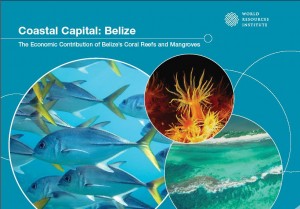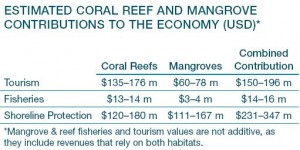« Recovering Used Oil in Colombia | Home | Progress Towards the Health MDGs in LAC / Progreso hacia los ODM relacionado con la salud en ALC »
Putting a Value on Belize’s Reefs and Mangroves
By Keith R | December 23, 2008
Topics: Economics & the Environment, Environmental Services, Marine/Coastal Issues | No Comments »
 In a recent post I applauded efforts to estimate the true economic value of the mangroves along the coast of Mexico’s Baja California. Last month the World Resources Institute (WRI) and World Wildlife Fund (WWF) released a report that estimates the economic value of Belize’s coral reefs and mangroves that I similarly applaud — in the hope that, by understanding the economic value of “services” that reefs and associated mangroves provide, and not just the aesthetic and biodiversity values of the reefs, the government, coastal communities and tourism and fishing industries will take better care of this resource.
In a recent post I applauded efforts to estimate the true economic value of the mangroves along the coast of Mexico’s Baja California. Last month the World Resources Institute (WRI) and World Wildlife Fund (WWF) released a report that estimates the economic value of Belize’s coral reefs and mangroves that I similarly applaud — in the hope that, by understanding the economic value of “services” that reefs and associated mangroves provide, and not just the aesthetic and biodiversity values of the reefs, the government, coastal communities and tourism and fishing industries will take better care of this resource.
The Belize report was released, not coincidentally, the same day as the sobering “report card” on the Mesoamerican Reef (MAR) system to which the Belize reefs belong, showing just how much this resource is endangered.
This is not the first reef valuation report WRI has done, and hopefully not the last. You can download PDFs of a consolidated report on the value of reefs in Tobago and St. Lucia or its executive summary.
 The main takeaway from the report? That Belize’s reefs provide up to US$559 million per year in environmental services — as much as 15% of Belize’s GDP in related tourism alone.
The main takeaway from the report? That Belize’s reefs provide up to US$559 million per year in environmental services — as much as 15% of Belize’s GDP in related tourism alone.
The report also makes some interesting policy recommendations for Belize:
1) Invest in management, monitoring, and compliance:
- Reinvigorate the Coastal Zone Management Authority and Institute and build capacity for monitoring the state and use of coastal resources.
- Tighten fishing regulations and invest greater resources in enforcement.
- Increase overall investment in marine protection areas (MPAs). Improve fee collection and monitoring of visitors.
- Build resilience to coral bleaching into the management and expansion of the MPA network.
2) Plan and implement development sensibly:
- Enforce land-use and development regulations in the coastal zone.
- Minimize the loss of mangroves along the shoreline – they play an especially important role in fisheries and shoreline protection.
- Conduct and thoroughly evaluate Environmental Impact Assessments and subsequent compliance plans for development in sensitive coastal areas, such as the cayes.
- Incorporate sewage and solid waste disposal in planning for tourism development. The cost of appropriate facilities can be compared to potential losses in reef services from further degradation.
- In planning a long-term tourism strategy, weigh revenues from a growing cruise industry against potential losses to the overnight sector from environmental impacts.
- Evaluate distributional effects (“winners” and “losers”) of proposed coastal development projects.
____________________
From the World Resources Institute (WRI):
Belize’s Reefs and Mangroves Tagged with High Economic Value
Three key services provided by coral reefs and mangroves in Belize are worth an estimated US$395 million to US$559 million per year, according to a report released today by the World Resources Institute and the World Wildlife Fund.
“Putting a dollar value on the goods and services provided by reefs and mangroves helps to translate them into a language that everyone speaks,” said Lauretta Burke, a senior associate at WRI. “Hopefully, these findings will contribute to well-informed decisions regarding the management of these critical resources.”
The report, Coastal Capital: Belize, estimates the annual economic value of coral reef- and mangrove-associated tourism in Belize at between US$150 million and US$196 million, accounting for between 12 and 15 percent of the Caribbean nation’s GDP. Benefits from reef- and mangrove-dependent fisheries contribute a further US$14 million to US$16 million to the economy.
Reefs and mangroves also protect coastal properties from erosion and wave-induced damage. WRI estimates that Belize’s coral reefs provide an estimated US$120 million to US$180 million in avoided damages per year. Mangroves protect the coastline from both waves and storm surge, providing an additional US$111 million to US$167 million in protection annually.
Despite growing recognition of the economic importance of coastal resources, reefs and mangroves face growing threats from unchecked coastal development, over-fishing, and pressures from tourism. Climate-related changes such as warming seas and fiercer storms will compound these impacts in the future.
“The goods and services offered by coral reefs and mangroves are frequently overlooked or underappreciated in coastal investment and policy decisions,” said Emily Cooper, a research associate at WRI and lead author of the study. “The amount currently invested in protecting Belize’s coral reefs and mangroves is very small when compared to the contribution of these resources to the national economy.”
Belize’s Marine Protected Area (MPA) system is widely hailed as an example of forward-thinking in marine conservation. Consisting of 18 protected areas managed primarily by the country’s fisheries and forestry departments in collaboration with local NGOs, the MPAs are an important draw for divers, snorkelers and sport fishermen, and contain no-fishing areas that help to maintain stocks of key commercial species. The system, however, is under-funded, and staff, fuel, and equipment limitations make it difficult to curb illegal fishing and monitor visitation in most of the reserves.
“Belize’s reefs and mangroves offer crucial socio-economic benefits but are already threatened by overuse, degradation and fragmentation. Climate change will undoubtedly compound these through increased frequency of impacts from mass bleaching and storm occurrences, as well as coastal erosion and sedimentation,” said Nadia Bood, Mesoamerican reef scientist and climate change officer for WWF Central America. “This makes urgent the need to act now to alleviate human threats and increase the resilience potential of these very important ecosystems.”
WRI’s Coastal Capital project receives key financial support from the Oak Foundation, the Netherlands Ministry of Foreign Affairs, SwedBio, the Campbell Foundation, and the MacArthur Foundation.
Tags: arrecifes, arrecifes coralinos, Belize, Campbell Foundation, cayes, coastal management, coastal zone management, coral reefs, erosion, MacArthur Foundation, manglares, mangroves, MPA, Oak Foundation, overfishing, recifes, reefs, SwedBio, tourism, turismo, WRI, WWF


